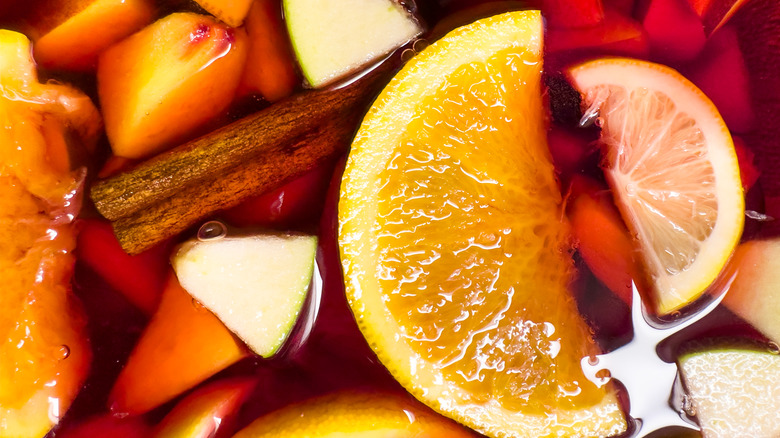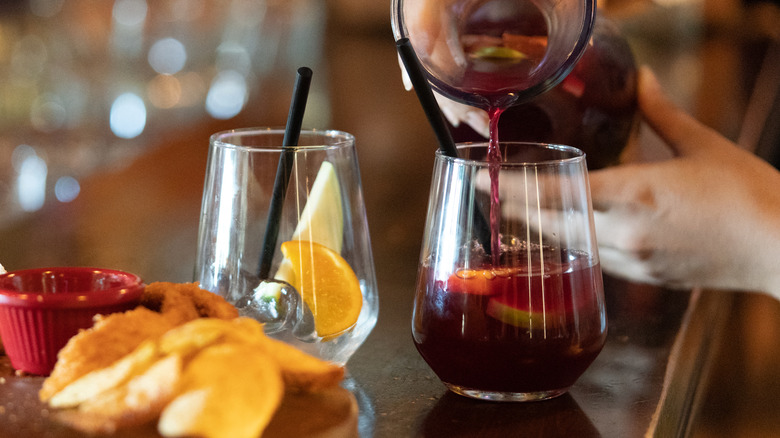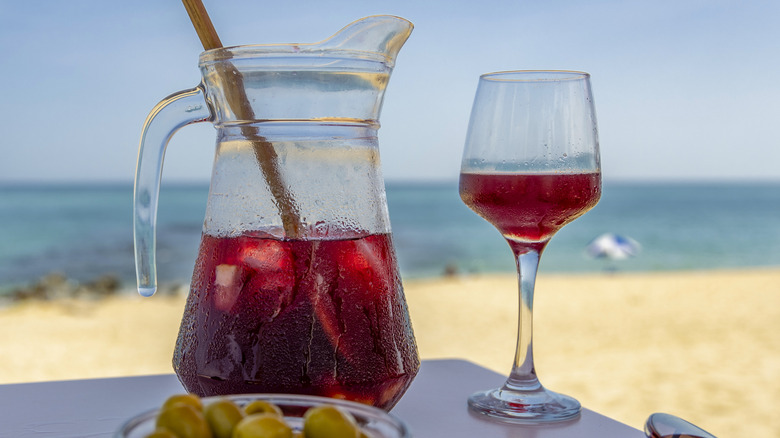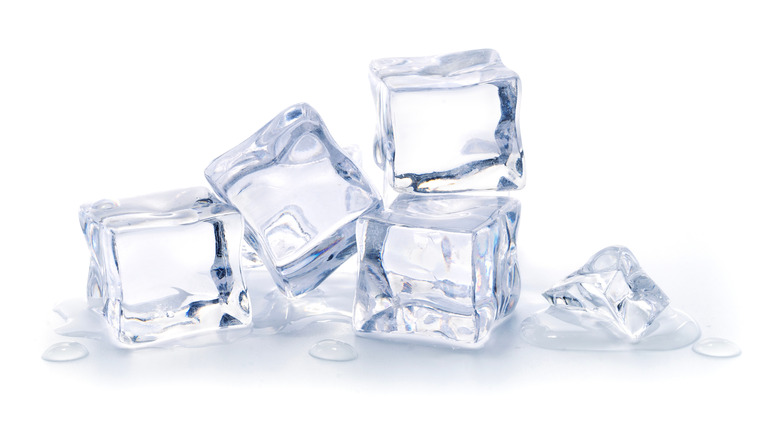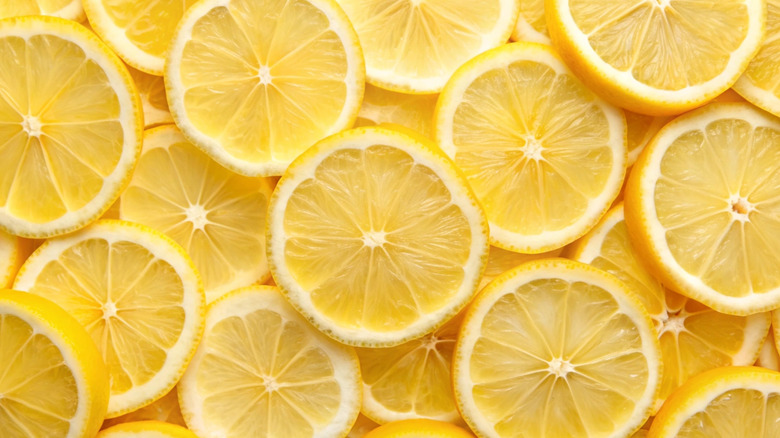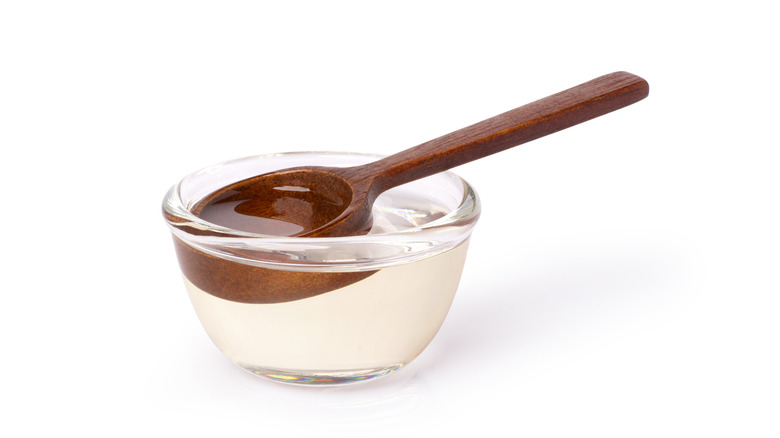10 Mistakes To Avoid When Making Sangria
Sangria, the wine-based, fruit-studded cocktail that hails from Spain, is a delight when you're craving a fruity beverage that tastes a bit more interesting than a simple bottle of wine. But if you've ever tried making sangria before, you might have realized that it's a bit more complicated than it looks. Although it may seem like you can just chuck some random fruit into a pitcher of wine and call it a day, it's actually a bit more difficult to achieve the perfect flavor balance.
If you've ever made a subpar sangria, you're not alone. There are many mistakes you can make when you're trying to build your own sangria, many of which we've listed here. Although I'm a WSET Level 3-certified wine writer, I've made several of these mistakes myself, and I had to figure out how to correct them the hard way. Hopefully, by being informed about the mistakes beforehand, you can ensure your next batch comes out perfectly. Learning how to make a proper sangria is a life skill that will earn you invites to a lot of fun parties, so let's take a closer look at some of the mistakes you should definitely avoid making (before you find out how to upgrade your next batch of sangria).
Not prioritizing using fresh fruit
We love a recipe that helps us reduce food waste by repurposing less-than-fresh leftovers. However, you shouldn't view a sangria as the kind of recipe that can help you get rid of fruit that's already starting to go mushy and bad. Because you may not be eating the fruit directly out of your glass, it's easy to assume that freshness doesn't really count for much here, but we think that fresh fruit really matters in a sangria.
Freshness matters first and foremost on the flavor front. As fruit ripens, it also becomes sweeter. You want some of that sweetness to come through in the sangria, of course, but it should be a well-balanced sweetness mixed with a nice amount of acidity. Overripe fruit may end up tasting too sweet in a sangria — especially if you're using a lot of it. It's not just about the flavor, though. Using fresh fruit also ensures that the fruit won't get too mushy in the pitcher, which can create an unpleasant texture as you're drinking the beverage.
Using super expensive wine
When you're making any wine-based cocktail, you don't want to use a super low-quality wine. After all, there aren't enough other ingredients in a sangria recipe that can make up for wine that tastes objectively bad. Therefore, you may want to skip the cheapest bottle on the shelf if you're trying to make a tasty sangria. At the same time, you really don't need to buy a super expensive bottle of wine.
Generally, if you're investing in a particularly good bottle of wine, you won't want to tamper with it at all. These bottles are not designed for mixed drinks — rather, they're meant to be enjoyed on their own. After all, a lot of the flavors in a high-quality wine are quite nuanced, and adding a bunch of fruit and sugar to the beverage is just going to mask the qualities that make it an expensive wine in the first place. Staying in the $15 to $20 range is likely going to be your sweet spot. Many of these wines will taste good on their own but won't be so expensive that you have to double-check your bank account before buying.
Not being choosy when deciding what ingredients to add
Sangria is an incredibly versatile drink. Although there are some ingredients you'll definitely need to include in the recipe, when it comes to the fruit, you can opt for a wide range of different flavors. For example, if you're making sangria in the warmer months of the year, you may want to focus on brighter, fresher fruit flavors, like orange and lemon. During other times of the year — especially when the weather starts to cool down — warmer flavors may start to sound better. Apples, pears, and cinnamon may be better options to tap into at this time of the year.
Just because all of these different ingredients can go into a sangria recipe, it doesn't mean that they should. Be choosy when it comes to picking what you want to include in a batch of sangria. For example, you might want to skip the cinnamon if you're serving the sangria poolside. At the same time, the addition of limes may feel a bit strange if you're focusing on warming spices. Stick to a specific theme with the fruit you choose, and don't add other random varieties just because.
Serving the sangria right after you're done mixing it
Can you technically serve sangria right after you've thrown all the ingredients together? Sure. But if you want it to taste as good as it can possibly get, it's not a great idea to serve it right away. First of all, you're going to want it to be cold. Even if you make sure all the different ingredients you're including in the recipe are cold when you prep them, you can probably get the pitcher a bit colder by putting it in the fridge for a while before you serve the drink.
More importantly, though, it's a good idea to let all of those different flavors mix and mingle for a while before you serve the beverage. The fruit juices will start to leak out into the rest of the beverage, and you'll be left with a sweeter, more flavorful, and more harmonious cocktail. We suggest storing your sangria overnight, at least, although waiting for up to 24 hours before serving is generally a good rule of thumb.
Assuming you can only use red wine
When most people think of sangria, the first drink that comes to mind is a red wine-based cocktail. And although we love sangria with red wine, it's not the only way to make the beverage. If you're more of a white wine person, you're in luck — sangria can be made with white wine, too. In fact, during the warmer months of the year, we prefer a white wine version because it often tastes lighter and spritzier than its red counterpart.
Wondering what kind of wine to choose for a white sangria? Go for a tart and citrusy wine, like albariño or sauvignon blanc. You don't have to spend a ton of money here, either — around $15 to $20 should do the trick. Then, feel free to get creative with your choice of fruit. Tropical fruits, like mango and pineapple, can make for a nice, sweet kick of flavor, or you could opt for a tarter flavor profile with raspberries and red cherries. When in doubt, citrus always does the trick.
Including too much or too little brandy in the recipe
Although sangria is a wine-based cocktail, that doesn't mean you can only include wine. In fact, if you want to make your sangria in a more traditional manner (and make it a bit boozier in the process), you're going to want to add brandy to the mix. This ingredient is important for a few reasons. First of all, it elevates what's essentially a fruit-infused wine into a proper cocktail. It'll have an ABV closer to what you would expect from a cocktail, as well as the flavor punch that can only come from a spirit. Additionally, brandy adds a rich depth and complexity that you just can't achieve with wine alone.
That being said, if you add too much brandy to the mix, it's likely to make your sangria taste way too strong, with a bitterness and intensity that isn't really appropriate for casual sipping. So, how much brandy should you add to your sangria? Generally, you'll want to use half a cup for every bottle of wine you include in the recipe.
Using room-temperature ingredients and adding ice
Sangria is generally the type of drink that you're going to enjoy on a hot day when you're on the hunt for a beverage that will cool you down. Therefore, it's really important to pay attention to the temperature of the ingredients you're working with — especially if you want that fresh, chilled flavor that makes sangria so appealing. Your best bet is to make sure all of your ingredients are cold when you add them to the sangria mix. Chill your wine and fruit ahead of time, and you'll have an ice-cold pitcher of sangria waiting for you.
Although you may assume that you can use room temperature ingredients and just add ice to the mix, we don't recommend taking this route. First of all, a bit of ice isn't going to give the beverage the chill it really needs, and when all that ice melts, you're going to be left with an especially watery sangria. Instead, taking that extra bit of time to chill the ingredients beforehand is key for the best-tasting sangria.
Incorporating too much sweetness into the recipe
One of the worst case scenarios you can encounter when it comes to making a sangria is including too many sweet elements into the drink. Does a good sangria have a touch of sweetness to it? Of course. But focusing too much on that can ultimately detract from the overall flavor of the cocktail, making it taste cloying and flabby. Plus, it can give you a much more virulent hangover if you include too much sugar into the mix. That being said, everyone has a different preference when it comes to sweetness, so you'll just want to add sugar slowly and taste as you go.
To avoid too much sweetness, first start with a dry wine. Almost all red wines on store shelves are going to be relatively dry (along with most whites as well), but make sure to ask someone for assistance if you want to make sure you're getting a wine without too much residual sugar. Then, try to rely on fruit to provide most of the sweetness in the beverage. Once you add the fruit, take a small sip to see if you like the sweetness level. If you'd still like a bit more sugar, add some orange juice, honey, or simple syrup for a touch of extra sweetness.
Forgetting to add an acidic element to the beverage
Sangria isn't known for being a deeply acidic cocktail — if anything, it leans toward the sweet end of the spectrum. But when you're working with sweet ingredients, you need to include a bit of acidity to balance things out. Some ingredients can play double duty, functioning as both a sweetener and an acidifier. Oranges and orange juice are perfect examples that create a beautiful balance in your pitcher. However, if you're someone who prefers for your sangria to taste a bit sharper than standard, you could consider adding lemon or lime slices to the mix. Even pomegranate juice can offer your sangria the touch of acidity it needs, as can green apples and even pears.
Of course, the ingredients you'll use to create acidity in your sangria will depend on whether you're using red or white wine. Citrus may be a better option for white sangria, while you may find that you enjoy pomegranates, pears, and apples better with red wine.
Using sugar instead of simple syrup
Not everyone wants to add additional sweetness to their sangria. For some, the sugar that comes from fruit is more than enough to give sangria its sweet, sugary flavor. However, others like a touch more sweetness in their beverage, and that's where extra sugar comes into play. Of course, if you're short on time, you can simply stir some granulated sugar into the cocktail. However, we prefer to avoid granulated sugar, since it doesn't dissolve easily and could leave your sangria with a gritty texture and unevenly distributed sweetness.
If you do want to give your sangria that extra pop of sweetness, try using simple syrup instead. Because simple syrup is a liquid, it combines with the wine better, ensuring that every sip is just as sweet as the last. To make your own simple syrup, you'll just need to use equal parts sugar and water. Make a big batch of it so you can use it for cocktails beyond your next pitcher of sangria.

